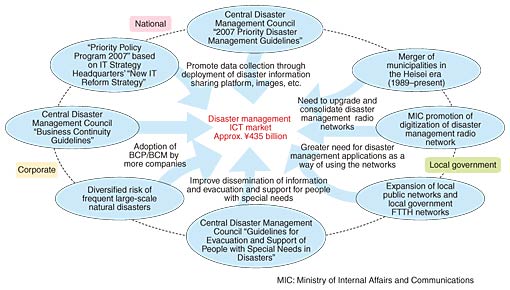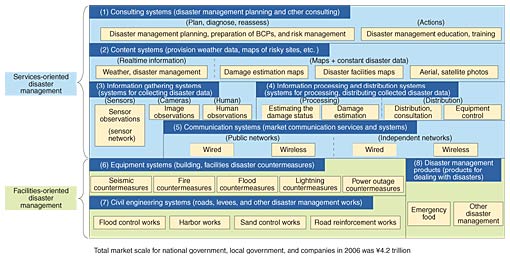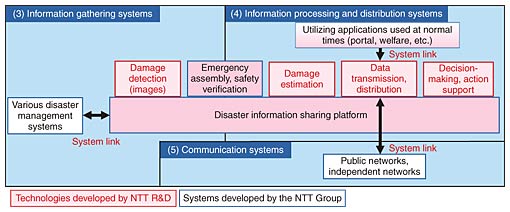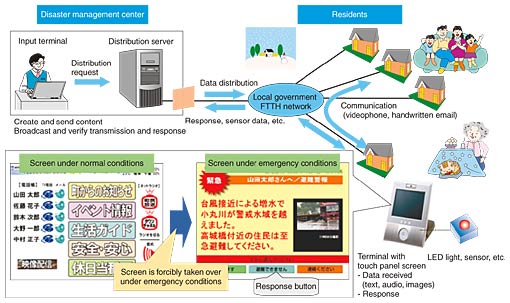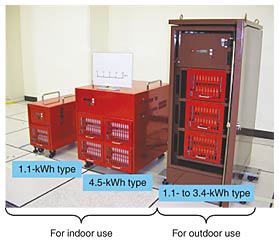 |
|||||||||||||||||||||||||||||||
|
|
|||||||||||||||||||||||||||||||
|
Letters Vol. 5, No. 10, pp. 54–60, Oct. 2007. https://doi.org/10.53829/ntr200710le2 NTT R&D Initiatives for Promoting Disaster Management BusinessAbstractThis paper highlights NTT's R&D initiatives for promoting the disaster management business provided by the NTT Group. In response to frequent large-scale natural disasters, national and local governments and companies are all taking steps to mitigate damage and enable fast recovery by upgrading national land and building stocks and leveraging information and communications technologies to deploy failsafe, rapid-response systems for collecting, transmitting, and sharing disaster information.
1. Market trends for disaster managementMajor natural disasters such as earthquakes, typhoons, and heavy snowfall occur fairly frequently in Japan, and they cause immense damage and destruction. Given the ever-present danger of a major earthquake in the Tokai region of central Japan and elsewhere, there has been a growing awareness of the importance of disaster preparedness and management not only at the national and local government levels, but also within the business community. A schematic overview of current disaster management initiatives and market trends in Japan is shown in Fig. 1. At the national level, the Central Disaster Management Council of the Cabinet Office puts out updated Priority Disaster Management Guidelines every year, and it is deploying a disaster information sharing platform and a centralized disaster information databank including images of devastation and other data [1]. The national government is also stepping up efforts to provide disaster information more quickly and to provide early warning information about earthquakes to mitigate damage and loss of life [1].
At the local government level, there is a need to upgrade and link up with the disaster management radio networks by merging local municipalities and to digitize the disaster management radio networks being promoted by the Ministry of Internal Affairs and Communications. Along with the further deployment of local public networks and local government FTTH (fiber-to-the-home) networks in cities, towns, and villages, there is a critical need for networks capable of two-way communication and image transmission to support disaster management, medical, welfare, and educational information services [2]. There is also a stepped-up effort, primarily at the municipal level, to implement systems for the evacuation and support of people requiring assistance during a disaster and to upgrade and enhance systems for disseminating information to the local population [3]. The total national and local government disaster management market is estimated to be about ¥3.3 trillion ($28 billion) a year, of which the annual ICT-related disaster management market is approximately ¥150 billon ($1.3 billion) a year (ICT: information and communications technology) [4]. Facing growing threats of widespread system failure, cyber terrorism, and other potential disruptions, business corporations are beginning to implement business continuity plans (BCPs) and business continuity management (BCM). Currently, 10 to 20% of large companies have BCPs [5] in place, and the Central Disaster Management Council is pushing to have business continuity plans and management practices adopted by virtually all large companies and more than 50% of medium-sized companies over the next ten years [6]. The companies seriously grappling with disaster management issues have prepared BCPs, applied antiseismic reinforcement to buildings, instigated better data backup procedures, and taken other measures to mitigate the potential damage from disasters. To eliminate bottlenecks and streamline operations and to restore operations within target timeframes, companies are also implementing BCM command support, conducting drills and training, and deploying safety verification and emergency contact systems [5], [7]. The total corporate disaster management market is approximately ¥900 billion ($7.7 billion) a year, of which the annual ICT-related disaster management market is roughly ¥285 billion ($2.4 billion). Thus, the total ICT-related disaster management market in Japan, for both government and corporate expenditure, is ¥435 billion ($3.7 billion) a year. 2. NTT Group products for disaster managementA schematic overview of the various business segments making up the overall disaster management market is shown in Fig. 2. The disaster management market can be broadly divided into two categories based on the national Basic Disaster Management Plan and Priority Disaster Management Guidelines: services-oriented disaster management products such as ones providing disaster information and facilitates-oriented disaster management products such as disaster countermeasures for buildings and equipment. Services-oriented products include (1) consulting systems, (2) content systems, (3) information gathering systems, (4) information processing and distribution systems, and (5) communication systems. Typical facilities-oriented products include (6) equipment systems, (7) civil engineering systems, and (8) other disaster management product systems.
Leveraging its core competencies, the NTT Group is primarily interested in new business opportunities focusing on information gathering systems, information processing and distribution systems, and communication systems (segments (3)–(5)) involving the deployment of wired and wireless communication services and local public networks, and applications that make effective use of ICT for collecting, sharing, and distributing disaster information. Some of the services-oriented disaster management solutions that NTT is currently developing include a remote surveillance system for assessing the damage to disaster-stricken areas in real time and a disaster information sharing platform; a safety verification and emergency contact system for verifying the safety of local residents and company employees; and digital maps, aerial and satellite photo maps, and a geographic information system. In the area of facilities-oriented disaster management solutions, NTT is working on various disaster countermeasure solutions including antiseismic reinforcement for buildings and innovative new power supply systems for disaster sites and emergencies. 3. Activities of the environmental and disaster prevention produce teamThe NTT Group is strongly committed to disaster management to achieve a safe and secure society, which is a key theme in the NTT Group's Medium-Term Management Strategy. The idea behind the environmental and disaster prevention produce team is to harness NTT's R&D results to create innovative disaster management businesses ahead of the market that create high-value-added offerings linked to the disaster management products made by NTT Group companies. Core activities of the environmental and disaster management produce team include:
A number of new businesses have already emerged out of these activities and reached the market. They include an emergency contact and safety verification system, a multihop wireless system to fill information gaps when disasters occur, and various other new disaster management products [8]. 4. NTT R&D initiativesNTT is pursuing wide-ranging research and development to make more effective use of ICT to establish contact and rapidly deliver information to potential victims and to prepare for disasters. Key R&D initiatives include (a) collecting and estimating wide-area disaster information in real time, (b) robust disaster-resilient data transmission channels linking multiple communication systems, (c) effective and certain distribution of information for elderly people and others with special needs, (d) support for rapid decision-making and action to deal with moment-by-moment changes at disaster sites, and (e) emergency power sources that operate reliably for long periods of time with minimal environmental impact, and (f) other commercial products (Fig. 3).
NTT Group has made significant progress in promoting better disaster management at the local government level by leveraging and upgrading its own wired and wireless networks to interwork with local government FTTH and disaster management radio networks to provide a failsafe system for distributing disaster information to local residents, regardless of their situation or where they live, and for verifying the state of data transmission. Moreover, in helping companies implement sound BCP/BCM procedures, NTT is developing a system that enables companies to collect and share disaster-related information and a convenient system that supports rapid decision-making and the issuing of instructions to other employees by the disaster response team supervisor. In order to collect disaster information in real time over a wide area from images, NTT is also developing a system that detects the extent of destruction and predicts the future status of disasters based on images transmitted from the actual disaster site. 4.1 Disaster information communication systemThis is a two-way communication system that enables local governments to broadcast evacuation orders and other emergency information to all residents at once when a disaster occurs and to verify the status and safety of residents (Fig. 4). It has three main features.
1) Certain distribution of informationThis system features a trigger scheme*1 that enables local government operators to verify the delivery to and response from residents when information is distributed when a disaster strikes. The number of simultaneous distributions and the distribution timing is controlled on the server side, and failsafe information distribution is determined from the server performance and the number of receiving terminals. 2) Information distribution for elderly people and others with special needsThe system uses the FLET'S phone*2 with a touch screen panel as the receiving terminal for local residents. The phone plays a full range of broadband content (text, audio, video) and also supports the delivery of involuntary push-type emergency messages. The recipient can respond to such an emergency message and indicate that he or she is safe merely by touching a button on the screen. 3) Everyday communicationThe system can be used for various purposes during ordinary conditions to support announcements and public services from local governments and also to support communication between residents by videophone, handwritten email*3, and other means. And because Web services are supported by a generic interface, the system can also be used in conjunction with local government portal systems and remote eldercare surveillance systems [9]. The system was designed specifically to support services for the elderly and other people with special needs. This system is used by local governments to provide information services over local public networks and FTTH networks administered by local governments.
4.2 Clean power supply system for disastersThis is a backup power supply system designed to operate for a long time. It uses large-capacity nickel-metal hydride (NiMH) batteries and a novel charge-discharge control scheme [10], [11] (Photo 1).
1) Compact and lightweightThe use of a high-energy-density nickel-metal hydride battery instead of a conventional lead-acid battery enabled drastic reduction in the size and weight of the system. Both are about one-third of the values for conventional systems. This new power supply system is also environmentally friendly because it does not use lead, which is a toxic substance, is whisper quiet, and does not emit exhaust fumes. 2) Excellent controllability and durabilityThe system features high-performance control functions including the detection of remaining battery capacity and fault conditions, as well as automatic charging and discharging. The system can be left outdoors in a fully charged state for prolonged periods in hot weather with practically no loss of power. At 45°C, the battery life is about eight years, which is close to twice the life of a conventional system based on lead-acid batteries. 5. Plans for the futureFurther work in this area is focusing on expanding the functional capabilities of disaster information communications systems to work with a greater range of terminal equipment and developing multiple routing schemes that interconnect NTT communication systems and networks run by local governments as a reliable way of delivering disaster-related information. And leveraging its expertise in ICT, the NTT Group is also pursuing a number of new disaster management businesses ventures, including consulting and operational support for business continuity plans and management and the development of realtime systems for collecting and estimating wide-area disaster information based on images. NTT Group also plans to pursue more collaborative activities and tie-ups among Group companies such as the Group's joint exhibit at the upcoming Security & Safety Trade Expo (RISCON TOKYO) 2007 in October. A photograph of last year's expo is shown in Photo 2.
References
|
|||||||||||||||||||||||||||||||








